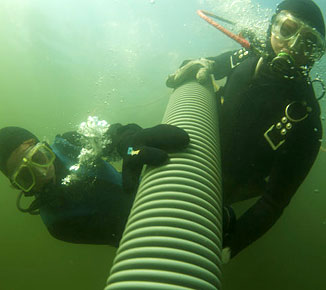Two of the most popular shows on cable television right now are about digging for gold. Exciting! Gold! One of these shows, the Discovery Channel’s Bering Sea Gold, focuses on the human difficulties and dangers of digging for gold under the sea floor off the coast of Alaska.
This pursuit of material mineral riches seems like it might be a bad idea for these individuals, especially that dude with the bloody hand. But when the gold is even deeper under the sea, digging it up could be an even worse idea. And at today’s inflated gold prices, digging up the ocean will be as lucrative as it could be destructive.
National Geographic’s feature story on deep-sea mineral mining sets up a scary proposition for the Solwara 1 site in Papua New Guinea especially, where one company hopes to blaze a path into the deep with new mining technologies that could allow for the scooping up of billions if not trillions of dollars worth of deep-sea minerals.
[A] fledgling deep-sea mining industry faces a host of challenges before it can claim the precious minerals, from the need for new mining technology and serious capital to the concerns of conservationists, fishers, and coastal residents.
The roadblocks are coming into view in the coastal waters of Papua New Guinea, where the seafloor contains copper, zinc, and gold deposits worth hundreds of millions of dollars and where one company, Nautilus Minerals, hopes to launch the world’s first deep-sea mining operation …
Samantha Smith, Nautilus’s vice president for corporate social responsibility, says that ocean floor mining is safer, cleaner, and more environmentally friendly than its terrestrial counterpart.
“There are no mountains that need to be removed to get to the ore body,” she says. “There’s a potential to have a lot less waste … No people need to be displaced. Shouldn’t we as a society consider such an option?”
But mining a mile below the sea’s surface, where pressure is 160 times greater than on land and where temperatures swing from below freezing to hundreds of degrees above boiling, is trickier and more expensive than mining on terra firma.
It’s trickier in part because the same undersea hydrothermal vent spots that are so full of gold and other fancy mineral deposits are also full of awesome sea creatures like seven-foot-long tubeworms and giant snails.
Conservationists also say they want to know more about the vent ecosystems and how they will be mined.
“The whole world is new to the concept of deep-sea mining,” says Helen Rosenbaum, coordinator of the Deep Sea Mining Campaign, a small activist group in Australia that campaigns against mining the Solwara 1 site.
“This is going to be the world’s first exploitation of these kinds of deep resources. The impacts are not known, and we need to apply precautionary principles,” she says. “If we knew what the impacts were going to be, we could engage in a broad-based debate.” …
A report released in November 2012 by the Deep Sea Mining Campaign ties exploratory pre-mining activities and equipment testing by Nautilus to “cloudy water, dead tuna, and a lack of response of sharks to the age-old tradition of shark calling.”
Shark calling is a religious ritual in which Papua New Guineans lure sharks from the deep and catch them by hand.
In the past 10 years, a dozen exploratory permits have been issued to governments around the world for drilling into international waters. Any over/under bets on when this all goes horribly wrong?




